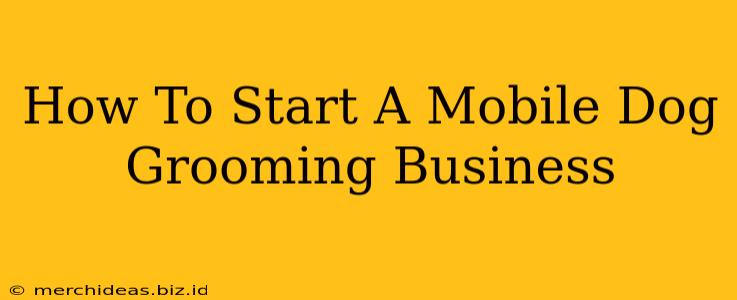Starting a mobile dog grooming business can be incredibly rewarding, offering flexibility and the chance to be your own boss. But success requires careful planning and execution. This guide will walk you through the essential steps to get your business up and running smoothly.
1. Market Research and Business Planning: Laying the Foundation
Before investing time and money, thorough research is crucial. This involves understanding your target market, your competition, and the overall demand for mobile dog grooming services in your area.
Understanding Your Market:
- Demographics: Identify your ideal client. Are you targeting busy professionals, families with young children, or owners of specific breeds?
- Competition: Research existing grooming businesses – both mobile and brick-and-mortar. Analyze their pricing, services offered, and marketing strategies. What are their strengths and weaknesses? How can you differentiate yourself?
- Demand: Assess the need for mobile grooming. Is there a significant pet-owning population in your area? Are there waiting lists at existing grooming salons? This will help you determine your potential client base.
Developing Your Business Plan:
A solid business plan is your roadmap to success. It should include:
- Executive Summary: A brief overview of your business concept.
- Company Description: Your mission, vision, and unique selling proposition (USP). What makes your mobile grooming service stand out?
- Market Analysis: Your research findings on demographics, competition, and demand.
- Services Offered: List the grooming services you'll provide (baths, haircuts, nail trims, etc.). Will you offer specialized services like breed-specific cuts or de-shedding treatments?
- Marketing and Sales Strategy: How will you attract and retain clients? (See Section 3)
- Financial Projections: Estimate your startup costs, operating expenses, and projected revenue. Secure funding if necessary.
- Management and Operations Plan: Detail your daily operations, including scheduling, client communication, and van maintenance.
2. Legal and Financial Aspects: Setting Up Shop Legally
Starting a business involves navigating legal and financial requirements. Make sure you're compliant with all relevant regulations.
Business Structure:
Choose a suitable legal structure for your business (sole proprietorship, LLC, etc.). This will affect your liability and tax obligations. Consult with a legal professional or accountant for guidance.
Licenses and Permits:
Obtain all necessary licenses and permits to operate legally. These may include:
- Business license: Required by your city or county.
- Pet grooming license: Specific requirements vary by location. Check with your state's licensing board.
- Vehicle permits: Ensure your van meets all safety and transportation regulations.
- Insurance: Obtain liability insurance to protect yourself from potential accidents or injuries.
Funding Your Business:
Determine your startup costs (van purchase or lease, equipment, supplies, insurance, marketing). Explore funding options, such as personal savings, small business loans, or crowdfunding.
3. Marketing Your Mobile Dog Grooming Business: Getting the Word Out
Effective marketing is crucial for attracting clients. Use a multi-channel approach to reach your target audience.
Online Marketing:
- Website: Create a professional website showcasing your services, pricing, and contact information. Include high-quality photos of your work.
- Social Media: Build a strong presence on platforms like Facebook and Instagram. Share engaging content, such as before-and-after photos, client testimonials, and behind-the-scenes glimpses of your work. Run targeted ads to reach potential clients.
- Online Directories: List your business on relevant online directories, such as Yelp and Google My Business.
Offline Marketing:
- Flyers and Brochures: Distribute flyers and brochures in local pet stores, veterinary clinics, and community centers.
- Networking: Build relationships with local vets, pet sitters, and dog walkers. They can be valuable referral sources.
- Local Events: Participate in local events, such as farmers' markets or pet adoption days, to raise awareness of your business.
4. Setting Up Your Mobile Grooming Van: Your Workplace on Wheels
Your mobile grooming van is your business's most important asset. Choose a van that's spacious, well-equipped, and easy to maintain.
Van Selection:
Consider factors such as size, fuel efficiency, and reliability. A larger van provides more space for equipment and comfort for the dogs.
Essential Equipment:
Invest in high-quality, professional grooming equipment, including:
- Grooming table: A sturdy, adjustable table for comfortable grooming.
- Dryer: A high-velocity dryer for efficient drying.
- Clippers and shears: High-quality clippers and shears for various coat types.
- Shampoos and conditioners: Pet-friendly shampoos and conditioners for different coat types and skin conditions.
- Other tools: Brushes, combs, nail clippers, etc.
Van Organization:
Organize your van efficiently to maximize space and minimize clutter. Use storage solutions to keep your equipment safe and easily accessible.
5. Providing Excellent Customer Service: Building Client Loyalty
Exceptional customer service is key to building a successful mobile dog grooming business.
Client Communication:
Maintain clear and consistent communication with clients. Confirm appointments, provide updates, and address any concerns promptly.
Professionalism:
Present a professional image at all times. Be punctual, courteous, and respectful to your clients and their pets.
Grooming Expertise:
Ensure you have the necessary skills and knowledge to provide high-quality grooming services. Continuously update your skills and knowledge to stay current with industry trends.
Starting a mobile dog grooming business requires dedication, hard work, and a passion for animals. By following these steps and staying organized, you can significantly increase your chances of success and build a thriving business. Remember that consistent marketing and exceptional customer service are critical for long-term growth and profitability.
